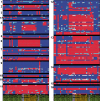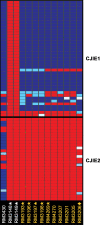Comparative genomic analysis of clinical strains of Campylobacter jejuni from South Africa
- PMID: 18431496
- PMCID: PMC2292242
- DOI: 10.1371/journal.pone.0002015
Comparative genomic analysis of clinical strains of Campylobacter jejuni from South Africa
Abstract
Background: Campylobacter jejuni is a common cause of acute gastroenteritis and is also associated with the post-infectious neuropathies, Guillain-Barré and Miller Fisher syndromes. In the Cape Town area of South Africa, C. jejuni strains with Penner heat-stable (HS) serotype HS:41 have been observed to be overrepresented among cases of Guillain-Barré syndrome. The present study examined the genetic content of a collection of 32 South African C. jejuni strains with different serotypes, including 13 HS:41 strains, that were recovered from patients with enteritis, Guillain-Barré or Miller Fisher syndromes. The sequence-based typing methods, multilocus sequence typing and DNA microarrays, were employed to potentially identify distinguishing features within the genomes of these C. jejuni strains with various disease outcomes.
Methodology/principal findings: Comparative genomic analyses demonstrated that the HS:41 South African strains were clearly distinct from the other South African strains. Further DNA microarray analysis demonstrated that the HS:41 strains from South African patients with the Guillain-Barré syndrome or enteritis were highly similar in gene content. Interestingly, the South African HS:41 strains were distinct in gene content when compared to HS:41 strains from other geographical locations due to the presence of genomic islands, referred to as Campylobacter jejuni integrated elements (CJIEs). Only the integrated element CJIE1, a Campylobacter Mu-like prophage, was present in the South African HS:41 strains whereas this element was absent in two closely-related HS:41 strains from Mexico. A more distantly-related HS:41 strain from Canada possessed both integrated elements CJIE1 and CJIE2.
Conclusion/significance: These findings demonstrate that CJIEs may contribute to the differentiation of closely-related C. jejuni strains. In addition, the presence of bacteriophage-related genes in CJIE1 may contribute to the genomic diversity of C. jejuni strains. This comparative genomic analysis of C. jejuni provides fundamental information that potentially could lead to improved methods for analyzing the epidemiology of disease outbreaks.
Conflict of interest statement
Figures




References
-
- Allos BM. Campylobacter jejuni infections: update on emerging issues and trends. Clin Infect Dis. 2001;32:1201–1206. - PubMed
-
- Snelling WJ, Matsuda M, Moore JE, Dooley JS. Under the microscope: Campylobacter jejuni. Lett Appl Microbiol. 2005;41:297–302. - PubMed
-
- Miller WG, Mandrell RE. Prevalence of Campylobacter in the food and water supply: incidence, outbreaks, isolation and detection. In: Ketley J, Konkel ME, editors. Campylobacter: Molecular and Cellular Biology. Norfolk, UK: Horizon Bioscience; 2005. pp. 101–163.
-
- Blaser MJ, Berkowitz ID, LaForce FM, Cravens J, Reller LB, et al. Campylobacter enteritis: clinical and epidemiologic features. Ann Intern Med. 1979;91:179–185. - PubMed
-
- Hughes RA, Cornblath DR. Guillain-Barré syndrome. Lancet. 2005;366:1653–1666. - PubMed
Publication types
MeSH terms
LinkOut - more resources
Full Text Sources
Molecular Biology Databases
Research Materials

